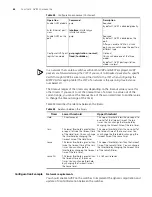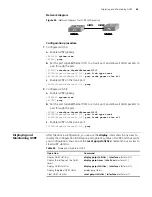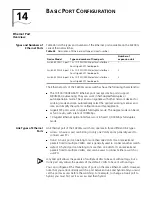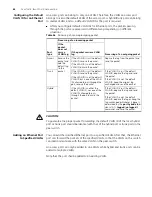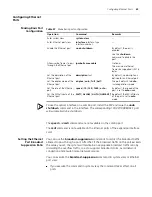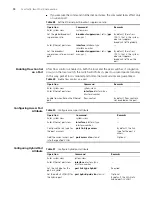
78
C
HAPTER
15: L
INK
A
GGREGATION
C
ONFIGURATION
Besides multiple-port aggregation groups, the system is also able to create single-port
aggregation groups, each of which contains only one port. LACP is enabled on the
member ports of dynamic aggregation groups.
Port status of dynamic aggregation group
A port in a dynamic aggregation group can be in one of the two states: selected or
unselected. In a dynamic aggregation group, both the selected and the unselected
ports can transceive LACP protocol packets; the selected ports can transceive user
service packets, but the unselected ports cannot.
In an aggregation group, the selected port with the minimum port number serves as
the master port of the group, and other selected ports serve as member ports of the
group.
There is a limit on the number of selected ports in an aggregation group. Therefore, if
the number of the member ports that can be set as selected ports in an aggregation
group exceeds the maximum number supported by the device, the system will
negotiate with its peer end, to determine the states of the member ports according to
the port IDs of the preferred device (that is, the device with smaller system ID). The
following is the negotiation procedure:
1
Compare device IDs (consist of two bytes system priority and six bytes system MAC
address, with the latter following the former) between the two parties. First compare
the two system priorities, then the two system MAC addresses if the system priorities
are equal. The device with smaller device ID will be considered as the preferred one.
2
Compare port IDs (consist of two bytes port priority and two bytes port number, with
the latter following the former) on the preferred device. The comparison between
two port IDs is as follows: First compare the two port priorities, then the two port
numbers if the two port priorities are equal; the port with smaller port ID is more
possible to become a selected port.
The port with half duplex attribute cannot receive or transmit LACP packets
.
Changing the system priority of a device may change the preferred device between
the two parties, and may further change the states (selected or unselected) of the
member ports of dynamic aggregation groups.
Link Aggregation
Attributes
Table 58 describes the link aggregation attributes of S4200-G series Ethernet
switches.
It is recommended that you configure the same type in both local and remote switch
if the number of member ports exceed the maximum number supported by the
device in a link aggregation group.
Table 58
Link aggregation attributes
Aggregatio
n mode
Switch
model
Cross-board
aggregation
Maximum number of
member ports in an
aggregation group
Maximum number
of selected ports in
an aggregation
group
Manual
S4200-G
series
Supported
Equal to the total number of
ports on the switch
8
Static LACP
Dynamic
LACP
Summary of Contents for 4200G 12-Port
Page 10: ...8 CONTENTS...
Page 14: ...4 ABOUT THIS GUIDE...
Page 46: ...32 CHAPTER 5 LOGGING IN THROUGH WEB BASED NETWORK MANAGEMENT SYSTEM...
Page 48: ...34 CHAPTER 6 LOGGING IN THROUGH NMS...
Page 60: ...46 CHAPTER 9 VLAN CONFIGURATION...
Page 64: ...50 CHAPTER 10 MANAGEMENT VLAN CONFIGURATION...
Page 80: ...66 CHAPTER 13 GVRP CONFIGURATION...
Page 98: ...84 CHAPTER 15 LINK AGGREGATION CONFIGURATION...
Page 112: ...98 CHAPTER 18 MAC ADDRESS TABLE MANAGEMENT...
Page 126: ...112 CHAPTER 19 LOGGING IN THROUGH TELNET...
Page 162: ...148 CHAPTER 20 MSTP CONFIGURATION...
Page 274: ...260 CHAPTER 29 IGMP SNOOPING CONFIGURATION...
Page 276: ...262 CHAPTER 30 ROUTING PORT JOIN TO MULTICAST GROUP CONFIGURATION...
Page 298: ...284 CHAPTER 33 SNMP CONFIGURATION...
Page 304: ...290 CHAPTER 34 RMON CONFIGURATION...
Page 338: ...324 CHAPTER 36 SSH TERMINAL SERVICES...
Page 356: ...342 CHAPTER 38 FTP AND TFTP CONFIGURATION...
Page 365: ...Information Center Configuration Example 351 S4200G terminal logging...
Page 366: ...352 CHAPTER 39 INFORMATION CENTER...
Page 378: ...364 CHAPTER 40 BOOTROM AND HOST SOFTWARE LOADING...
Page 384: ...370 CHAPTER 41 Basic System Configuration and Debugging...
Page 388: ...374 CHAPTER 43 NETWORK CONNECTIVITY TEST...
Page 406: ...392 CHAPTER 45 CONFIGURATION OF NEWLY ADDED CLUSTER FUNCTIONS...

